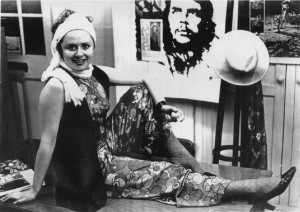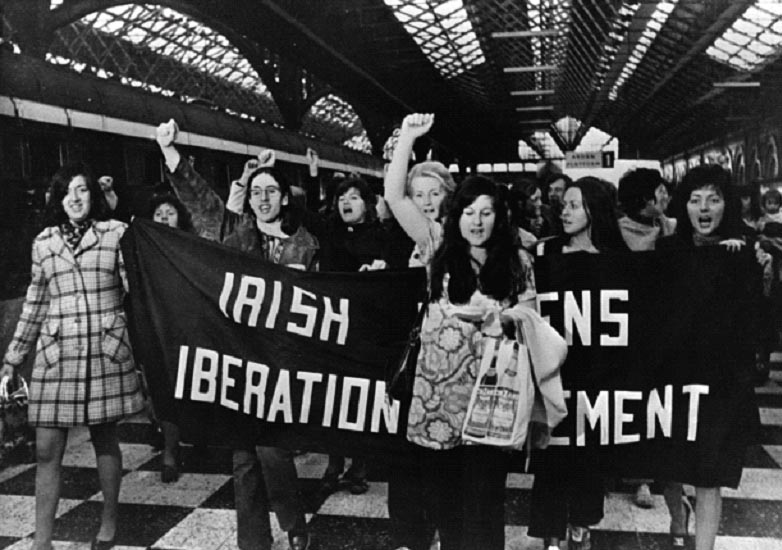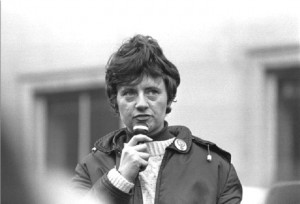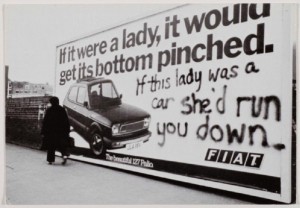Recollections of the Irish Women’s Liberation Movement
Published in 20th Century Social Perspectives, Features, Issue 5 (September/October 2015), Volume 23THE FEMINIST MOVEMENTS OF THE 1960S AND 1970S ELSEWHERE WERE IN ESSENCE MODERNISATION MOVEMENTS; IRELAND’S TIME-LINE WAS DIFFERENT.

Mary Kenny c. 1970. (Irish Press)
The feminist organisation of which I was a founding member in 1970 was called the ‘Irish Women’s Liberation Movement’ (IWLM). It is historically inappropriate to call it ‘the women’s movement’ as there were many different ‘women’s movements’, ranging from the Irish Housewives’ Association and the Irish Country-women’s Association to the various feminist Trotskyist and Maoist groups at a different end of the spectrum.
When I was actively involved with the IWLM, it was in the full spirit of youthful rebellion against what I saw as a stuffy and archaic social order. Those of us who had been born in the 1940s grew up in a world that was still, in many respects, Victorian. Our parents, aunts and uncles had been born at the beginning of the twentieth century (in my case, my father had been born in 1877, which was before James Joyce!). So we inherited a very traditional social order that was bound to change with the passage of time.
European context
Many of these archaic laws and regulations were by no means confined to Ireland: France, for example, had a ‘suppression of contraception’ law on the statute books until 1967, and even then it took some years to propel this change through the Assemblée Nationale. But laws were not always observed: people got around them, or sometimes they fell into desuetude. So an over-rigid interpretation of historical conditions isn’t always an accurate guide to how people actually lived.
The marriage bar—whereby a married woman was expected, or enjoined, to resign her post once she got married (although it was only implemented in government or semi-state service; it did not extend to the private sector)—had obtained all over Europe until the Second World War. It’s important to put the restrictions that prevailed for Irish women into a wider European context. The feminist movements of the 1960s and 1970s (in America, too) were in essence modernisation movements, which were shrugging off older values that obtained almost universally.
Ireland’s time-line was different, mostly because of neutrality during the Second World War; what changed in the late 1940s in some other countries began to shift in Ireland in the 1960s. In Britain, restrictions on married women working in state or semi-state jobs—as teachers, for example—were dissolved during the war, mostly because of the need for female labour. Even so, during the 1950s women in the British civil service did not rise above a certain (often quite menial) level unless they were single. An exception was made for the local postmistress—but in Ireland, too, the postmistress might sometimes be a married woman. The subject of married women returning to work—like equal pay—was opposed by the trade unions everywhere. The male-dominated trade unions feared that the job rates for men would fall if women entered the workforce. There was a fear that the rise of the middle-class woman in the labour force would mean the decline of the working-class male.

Chequebooks and credit cards
Looking back at the IWLM of 1970, the issues that concerned us were several. The more left-wing tendency was focused on housing, which, after all, had sparked the Civil Rights movement in Northern Ireland. Actually, even the bourgeois members were concerned with housing, as we considered it outrageous that a woman could not get a mortgage without the support of a man’s signature; indeed, when a young couple sought a mortgage, the woman’s income was not ‘counted’, as it was assumed that she would quit her job when she had a baby.
This did not fall into the realm of law but into that of business practice. Another business practice that we considered wholly unacceptable was when department stores made credit cards available to women, but only with the countersignature of a man. (This was also the case in other countries: in France a woman could not obtain a chequebook without a male guarantor until 1965.)
What riled us in the IWLM on this question of money was that we thought that women were often more responsible about finance than men, and, as mothers in the home, were more careful about budgeting and housekeeping. Interestingly, the financial prejudice against women was more middle-class than working-class: in working-class households, the ‘good husband’ quite often handed over his entire wage packet to his wife, and she would give him back his spending money for the week. There have been numerous studies that indicate that middle-class wives at that time knew far less about how much their spouses earned than did working-class women.
Jury service
The exclusion of women from jury service was a serious issue, especially for one of our most vigorous campaigning members, Máirín de Burca (who was also active in the housing campaign). It was Máirín who provided Mary Robinson with much of the material to get this regulation changed. Yet a historical note, again, is appropriate: at the birth of the Free State in 1923, Irishwomen were called for jury service, but so many women asked to be excused that the justice minister, Kevin O’Higgins, decided in 1926 that it would simplify procedures not to call women at all.
There was a provision whereby a woman could apply for jury service but, again, it was unusual, and if someone requested to serve on a jury, the defending attorney could object. Nevertheless, I do feel, in retrospect, that we should have blamed our mothers, grandmothers and aunts for not choosing to do their jury duty back in the 1920s and thus causing the exclusion of women later. (On a personal note, I much regret that I have never been called for jury service and, ironically, I am now considered too old: so ageism rather than sexism has thwarted my desire to perform this citizen’s duty.)
The issue of getting a barring order against a violent husband was certainly an important one, but a far more frequent problem was the plight of the deserted wife. We thought it a scandal that 1,500 Irishwomen were simply ‘deserted’ each year—the husband just upping sticks and leaving (often going to England and disappearing into the anonymity of a big city). These women had no entitlements or rights, were in a legal limbo, and had no welfare benefits either. We were also concerned about the plight of the unmarried mother, who was entitled to no benefits (but lots of hostility). Widows, too, complained that they were sidelined and I remember receiving many letters about this. A lobby to support single mothers, Cherish, and an organisation for widows, Cruise, duly appeared and were very constructive.

Máirín de Burca—one of the IWLM’s most active members—successfully campaigned for the inclusion of women on jury service by 1975. (RTÉ Stills Library)
Conjugal rights
I do not remember the question of a husband’s ‘conjugal rights’ being an issue. Perhaps discourse about sexual issues was still a little more decorous at that time. It was, of course, considered an obligation of the married state that the spouses be receptive to one another in the sexual arena, but I don’t think we were aware that it had the backing of the law. Universally, indeed, rape in marriage was not legally admissible (although any assault is still an assault), but what goes on in the bedroom of any couple can be difficult to police, and the whole point of abrogating the 1935 contraception law was to get the state out of the bedroom, not to involve the state even more in that area.
My own experience of marriage—those among whom I grew up, and those I have known, including my own, over a lifetime—is that, whatever the slogans say, there is no such thing as ‘equal marriage’; one partner always has more power than the other, and it is not always the man. I was raised by an aunt and uncle, and my aunt dominated her husband in every single respect—and I imagine that what prevailed in the kitchen, the living room and even the race track (where she chose the horses to back) probably also applied in the bedroom.
I think that caution has to be exercised before making generalisations of power around sex. Men have physical power, but women, in times gone by, often had power of emotional control and power of sexual scarcity, too: many men couldn’t get to have sexual relations with women because women controlled what might be called ‘the chastity imperative’ before marriage. The social and religious prohibition against sex before marriage (strongly upheld by the British agony aunts, for example, until the later 1960s) meant that women had the social power to rebuff males. In some cases, this must have remained after marriage (although individuals always vary).

‘If this lady was a car . . .’—feminist graffiti from 1979. (Jill Posner)
As single and liberated young women, we all heard married men grumbling that their wives didn’t understand them, or that they didn’t get enough sex at home, so presumably in these cases they didn’t ‘force’ their wives to have conjugal relations. Pleading sex-starvation at home was a staple of married men out on the hunt for extra-marital relationships.
Divorce and contraception
What’s interesting is that we did not, in the IWLM, broach the subject of divorce at all. I think that this may have been (like abortion) a bridge too far at that time. But I think it may also have been that we didn’t perceive a very great demand for it. Letters from women readers to the women’s pages of the newspapers (many of us worked in journalism) seldom mentioned divorce: money problems, drink problems, desertion and, yes, too-frequent childbearing were the issues to the fore. Besides, I think that the property laws would not have been favourable to women in divorce in the 1970s.
There certainly was an expressed need for contraception, although we have to respect the fact that people had a variety of attitudes to birth control. Over the course of the twentieth century, birth control itself, in many societies, was only gradually accepted. The Church of England did not fully accept contraception, and then only strictly within marriage, until 1958. By the 1940s the Protestant churches had accepted contraception for health reasons, though it also took them some time to accept contraception for pleasure. The biblical injunction to ‘go forth and multiply’ was widely interpreted by Jews and Christians for centuries as meaning that fertility must be honoured. (Judaism expected the couple to have two children before controlling their fertility.)
By a twist of fate, Queen Elizabeth the Queen Mother played a role in advancing birth control for the Anglican Church. She could only give birth by Caesarean section and after the birth of a second daughter (Princess Margaret, in 1930) was warned by physicians not to have another child. And thus birth control was endorsed for health reasons for the queen of England, wife of the head of the Anglican Church (and that is also why there was no further attempt to have a son).
The historical background to contraception and fertility is part of a context. Ireland’s law against importing ‘birth control artefacts’ was not particularly unusual in 1935 (several American states had similar laws, including the overwhelmingly Lutheran Minnesota). I also suspect, aside from the religious background, that the fear of under-population might have played a subconscious role in hostility to birth control. Farming societies are nearly always pro-natalist: in animal husbandry, barrenness is failure.
The Pill
By the 1970s, this 1935 law was evidently archaic and needed to be abrogated. The contraceptive pill, which appeared in 1961, probably made a considerable contribution to making birth control laws seem obsolescent. The Vatican had had a long consultative process about the contraceptive pill, from the earlier 1960s until 1968, when Pope Paul VI reiterated the papal view that it was not in accordance with Catholic moral theology (although most of his advisers had counselled him to accept it).
The Pill itself was an extraordinary breakthrough in the development of contraception because it was so discreet, aesthetic and reliable. Women could use it without even telling their husbands or boyfriends, so it put women totally in control. And for those (as in the Jewish tradition) who were uncomfortable with the idea of a piece of vulcanised rubber coming between a husband and wife, the Pill literally placed no barrier between the couple. Paradoxically, the widespread public discourse about the contraceptive pill was a kind of advertisement for it. And it never fell under any anti-birth control law in Ireland, since, obviously, it hadn’t been invented in 1935 and, in any case, it was a medication rather than a ‘birth control artefact’.
Some doctors (and perhaps some women) preferred to call it a ‘cycle regulator’. For some women with irregular periods, it could regularise their cycles, and there remained considerable interest, among Catholics, in natural family planning (though it was ragged as ‘Vatican roulette’). But the contraceptive pill was, clinically, exactly the same product in the Republic of Ireland as it was elsewhere: clinically, it was labelled an ‘anovulant’. That is to say, it suppressed ovulation. The big pharmaceutical corporations (for whom it was a goldmine) were not inclined to label it ‘contraceptive’ anyway, just in case, unusually, a conception took place and they might be sued for compensation. I think that the contraceptive pill was very widely used in Ireland by 1970, though I’m not sure whether there have been any clinical studies about this. But I remember conversations within our IWLM meetings in which it was suggested that perhaps the Pill was too widely used—because there were not sufficient alternatives.
Unforeseen consequences
In 1970 I saw these questions as being an important element of going forward and necessary change, and, indeed, many changes were needed and sometimes overdue. With the perspective of history, you see change as part of a historical narrative, which is often more complex than it seems when it is actually happening. Change is a necessary part of life, but there are always consequences to change, and often unforeseen consequences, which will be for another generation to deal with; and here I will just highlight one such example. A woman of my own vintage told me recently:
‘When we got married in the late 1960s, I had to quit my job in the civil service, which I regretted. Yet we were able to acquire a home of our own, in a lovely part of south County Dublin, with a down payment on my husband’s salary—I think the house cost about £3,500 at the time. My daughter didn’t have to quit her job, but I am not sure if her generation will ever get on the property ladder at all.’
Life is like a Rubik’s cube: you fix one problem and another pops up, and fortunate is the person who can get all the squares in line.
Mary Kenny’s most recent book is Something of myself and others (Liberties Press, 2014).
















